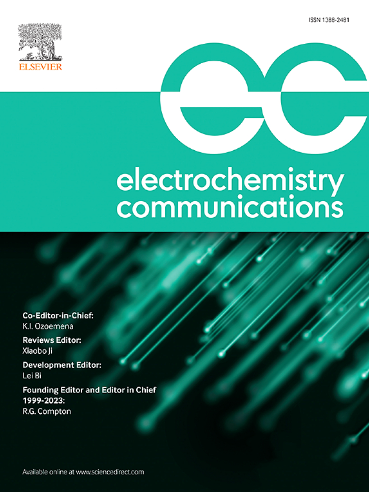Corrosion of nickel foam electrodes during hydrothermal reactions: The influence of a simple protective carbon black coating
IF 4.2
3区 工程技术
Q2 ELECTROCHEMISTRY
引用次数: 0
Abstract
Nickel foam (NF) substrates are widely used to support electrocatalysts, and this is frequently achieved using hydrothermal reactions, where the NF is immersed in the hydrothermal reactor together with the electrocatalyst precursors. However, other reactions including the corrosion of the NF and changes to the pH occur simultaneously, and these can affect the quality of the final electrocatalyst. Herein, a simple approach is devised to minimise these unwanted reactions. Carbon black (CB) was non-covalently functionalised at room temperature using tannic acid to give very stable and good dispersions of fCB in deionised water. Using a simple sonication step, the NF was coated with a uniform layer of the dispersed fCB. This layer served to minimise the corrosion of the underlying NF during the hydrothermal reactions with very good protection observed up to a temperature of 160 °C in deionised water at a pH of 2.0. The corrosion currents of the NF and fCB@NF were estimated at 8.7 µA and 3.9 µA, respectively, at room temperature in this acidic solution. Using a model reaction, the successful nucleation and growth of MnCo2O4 cubes was observed at fCB@NF, but not at the corroding NF.
水热反应过程中泡沫镍电极的腐蚀:简单碳黑保护层的影响
泡沫镍(NF)基材被广泛用于支持电催化剂,这通常是通过水热反应来实现的,即把 NF 与电催化剂前体一起浸入水热反应器中。然而,同时还会发生其他反应,包括 NF 的腐蚀和 pH 值的变化,这些都会影响最终电催化剂的质量。在此,我们设计了一种简单的方法来尽量减少这些不必要的反应。使用单宁酸在室温下对炭黑(CB)进行非共价官能化,从而在去离子水中得到非常稳定和良好的 fCB 分散体。通过一个简单的超声步骤,就能在 NF 上涂上一层均匀分散的 fCB。在 pH 值为 2.0、温度高达 160 °C 的去离子水中,这层涂层可以最大程度地减少水热反应过程中对下层 NF 的腐蚀,起到很好的保护作用。在室温下的酸性溶液中,NF 和 fCB@NF 的腐蚀电流估计分别为 8.7 µA 和 3.9 µA。利用模型反应,在 fCB@NF 上观察到了 MnCo2O4 立方体的成功成核和生长,但在腐蚀 NF 上却没有观察到。
本文章由计算机程序翻译,如有差异,请以英文原文为准。
求助全文
约1分钟内获得全文
求助全文
来源期刊

Electrochemistry Communications
工程技术-电化学
CiteScore
8.50
自引率
3.70%
发文量
160
审稿时长
1.2 months
期刊介绍:
Electrochemistry Communications is an open access journal providing fast dissemination of short communications, full communications and mini reviews covering the whole field of electrochemistry which merit urgent publication. Short communications are limited to a maximum of 20,000 characters (including spaces) while full communications and mini reviews are limited to 25,000 characters (including spaces). Supplementary information is permitted for full communications and mini reviews but not for short communications. We aim to be the fastest journal in electrochemistry for these types of papers.
 求助内容:
求助内容: 应助结果提醒方式:
应助结果提醒方式:


